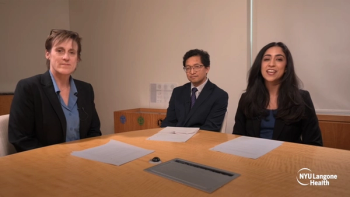
- Ophthalmology Times: November 1, 2020
- Volume 45
- Issue 18
Investigators show long-term visual declines in DME eyes
Protocol T Extension Study details methods needed to maintain VA gains over time.
While the final VA at the 5-year mark remained above that achieved at the end of the Protocol T study, the results emphasized the need for methods to maintain the initial VA increases achieved. Dante Pieramici, MD, reported the results of the Protocol T Extension Study on behalf of the DRCR Retina Network.
Related:
Protocol T was a 2-year multicenter clinical trial in which aflibercept (Eylea, Regeneron Pharmaceuticals), bevacizumab (Avastin, Genentech, Inc.) and ranibizumab (Lucentis, Genentech, Inc.) were compared for treating DME in 660 eyes in which the baseline VAs ranged from 20/32 to 20/320.
All patients had center-involved DME and had received no or minimal treatment for the DME, according to Pieramici, who is in private practice in Santa Barbara, California.
Protocol T Extension study results
In the extension study, the eligible patients were assessed during a 5-year visit, 3 years after the end of Protocol T.
At the 5-year visit, the VA was measured, optical coherence tomography images and color photographs were obtained, and patients were examined.
Related:
“The primary objective of the extension study was to obtain additional information about the 3 years after the end of Protocol T to gain insight into the treatment course and follow up on the VA and DME in years 2 to 5,” Pieramici said.
Pieramici pointed out that the main outcome was not to compare the treatments groups after 2 years because the patients had been managed at physician discretion during that time.”
A total of 317 patients were eligible to participate in the extension study. Among them, 95% of the participants had undergone 1 or more retinal examination (mean, about 14) since the end of Protocol T.
During the 2- to 5-year period, 70% of patients were treated 1 or more times for DME or diabetic retinopathy, most of which were anti-VEGF drugs (median number of injections, 4 in about 67% of patients); small percentages of patients were treated with corticosteroids, focal or grid laser, or panretinal photocoagulation, according to Pieramici.
Related:
About one-third of patients did not receive additional VEGF injections during the period of the extension study, and about 10% received 20 or more injections during the evaluated time period.
“At the end of the extension study, the VA decreased to an average of +7.4 letters compared with the Protocol T increase of +12.2 letters in all treatment groups, for a mean decrease of about 1 line of VA,” Pieramici pointed out. “However, this level was still better than the baseline VA. When the effects of anti-VEGF treatments were analyzed, the same downward trajectory was seen for the 3 drugs.”
When the VA was analyzed according to the baseline VAs, the same pattern of results was seen.
However, despite the VA decline over the 3-year period, almost 50% of the patients had 20/25 or better VA at the 5-year time point and 75% had 20/40 or better VA.
The mean central subfield thickness changed very little between years 2 and 5, -156 μm versus -154 μm, respectively. This also was the case when the groups were analyzed based on the original treatments. At 5 years, only about one-third of patients had some measurable DME.
Related:
Based on the results of the Protocol T Extension Study, the takeaway points are:
- The patients received standard care after Protocol T concluded. That is, 95% of patients received retinal care and 68% had at least 1 injection of an anti-VEGF drug. On average, the patients maintained VA gains from baseline, but the mean VA decreased from years 2 to 5, and the central subfield thickness did not change significantly during those years;
- The results of the Protocol T Extension Study differed from previous studies of DME that reported sustained VA increases, as in the Protocol I study; and
- Strategies are needed to improve the long-term VA outcomes in the clinical care of eyes with DME.
Read more by Lynda Charters
---
Dante Pieramici, MD
e:[email protected]
Pieramici is a consultant to and receives research funding from Genentech Inc and Regeneron Pharmaceuticals.
Articles in this issue
about 5 years ago
Investigators study home-based monitoring for exudative AMDabout 5 years ago
Ocular gene therapy offers hope for inherited retinal diseaseabout 5 years ago
Good nutrition optimizes ocular surface in premium cataract patientsabout 5 years ago
Extended depth-of-field IOLs: Clarifying current nomenclatureabout 5 years ago
Developing retinal technologies strengthen visualizationabout 5 years ago
Building a brand is key to developing successful practiceabout 5 years ago
Changing patient conversations around cataract surgeryabout 5 years ago
Planning is important — even when “nobody knows nothing”Newsletter
Don’t miss out—get Ophthalmology Times updates on the latest clinical advancements and expert interviews, straight to your inbox.













































